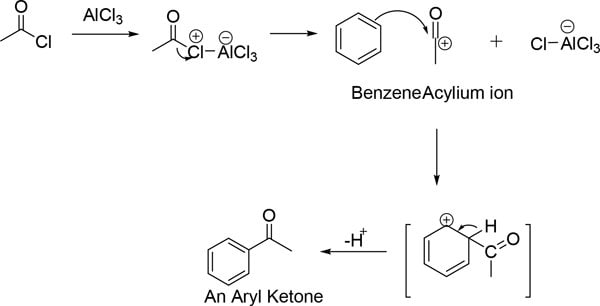Friedel–Crafts Acylation
Limitations of Friedel–Crafts Acylation
- Reactivity of Aromatic Compounds: Highly deactivated or electron-poor aromatic compounds may not react effectively, limiting the scope of substrates that can be used.
- Formation of Multiple Products: The reaction can lead to polysubstitution, where more than one acyl group is introduced, making it challenging to control the degree of substitution.
- Rearrangement of Acylium Ion: The acylium ion formed during the reaction can undergo rearrangement, leading to unexpected products or side reactions.
- Use of Strong Lewis Acids: The reaction typically requires strong Lewis acids (e.g., AlCl₃) as catalysts, which can be moisture-sensitive and may complicate workup and purification.
- Limitations with Certain Functional Groups: Functional groups that are sensitive to the reaction conditions (e.g., alcohols, amines) may be incompatible, limiting the range of substrates.
- Environmental and Safety Concerns: The use of hazardous reagents and solvents can pose safety and environmental risks.
- Limited to Acyl Groups: Friedel–Crafts acylation specifically introduces acyl groups, which may not be suitable for all synthetic needs, limiting its versatility compared to other acylation methods.
Reaction
The Friedel–Crafts acylation is the reaction of an arene with acyl chlorides or anhydrides using a strong Lewis acid catalyst. This reaction proceeds via electrophilic aromatic substitution to form monoacylated products.1,2

Figure 1.Friedel–Crafts acylation reaction shown as molecular structures
Friedel–Crafts Acylation Mechanism
The Friedel–Crafts Acylation reaction involves formation of a complex between the Lewis acid and the chlorine atom of the acid chloride. An acylium ion is formed by the cleavage of C-Cl bond of the complex. The acylium ion has a positive charge on the carbon and is resonance stabilized. This acylium ion acts as an electrophile and reacts with the arene to yield the monoacylated product (aryl ketone).1

Figure 2.Friedel-Crafts acylation mechanism with an AlCl3 catalyst shown as molecular structures
Applications
The Friedel–Crafts acylation reaction is useful for the synthesis of:
- Diarylacetic acid derivatives4
- Poly(oxy-1,3-phenylenecarbonyl-1,4-phenylene) or mPEK5
- 1,5-Bis(4-fluorobenzoyl)-2,6-dimethylnaphthalene6
- Aromatic ketones7
- Dissymmetric aromatic amines8
- Cyclic ketones such as 1-indanone and 1-tetralone9
- 2-Acetyl-6-methoxynaphthalene, an intermediate for the synthesis of naproxen10
Research and Trends
- Poly(4-vinylpyridine) supported trifluoromethanesulfonic acid has been employed as efficient and an easy-to-handle, solid, superacid catalyst system in Friedel–Crafts reactions. One pot solvent-free synthesis of various diarylacetic acid derivatives was achieved by Friedel–Crafts hydroxyalkylation reaction of glyoxylic acid with arenes under mild conditions.4
Scheme of the above synthesis:

Figure 3.One pot solvent-free synthesis of diarylacetic acid derivatives by Friedel–Crafts hydroxyalkylation reaction of glyoxylic acid
- An imidazolium-based ionic liquid catalyzed the Friedel–Crafts acylation of aromatic compounds with acetyl chloride.11
- Erbium trifluoromethanesulfonate is reported to be a good catalyst for the microwave-assisted Friedel–Crafts acylation of arenes containing electron-donating substituents.12
- The intramolecular Friedel–Crafts acylation is used in the direct and short construction of the ACDE ring system of daphenylline, a novel daphniphyllum alkaloid.13
- The acid-promoted domino Friedel–Crafts acylation reaction has been developed for building the core 6,5,6-ABC tricyclic skeleton of taiwaniaquinoids. It is also used in the syntheses of diterpenoids (±)-taiwaniaquinol B and (±)-dichroanone.14
- Novel poly(aryl ether ketone)s and poly(aryl ether ketone sulfone)s containing 1,4-naphthylene units have been synthesized by electrophilic Friedel–Crafts acylation polycondensation reactions.15
- The Friedel–Crafts acylation of toluene with acetic anhydride over triphenyltin grafted on SBA-15 mesoporous silica has been reported.16
- Indium triflate in the ionic liquid, 1-isobutyl-3-methylimidazolium dihydrogen phosphate ([i-BMIM]H2PO4), forms an efficient green catalyst system for the Friedel–Crafts acylation of aromatic compounds with acid anhydrides.17
- Friedel–Crafts acylation of 25,27-dialkoxycalix[4]arenes using acyl chlorides and AlCl3 in 1,2-dichloroethane have been reported.18
To continue reading please sign in or create an account.
Don't Have An Account?